- Joined
- Feb 2, 2011
- Messages
- 2,093
NEW RELEASES FOR AUGUST 2023
THE ANCIENTS COLLECTION
ARMIES AND ENEMIES OF GREECE AND MACEDONIA
THE ACHAEMENID PERSIAN EMPIRE 550-330BC
The Achaemenid Empire c. 550–330 BC, also called the First Persian Empire, was an ancient Iranianempire based in Western Asia founded by Cyrus the Great. Ranging at its greatest extent from the Balkans in the west to the Indus Valley in the east, it was larger than any previous empire in history, spanning 5.5 (or 8) million square kilometers. Incorporating various peoples of different origins and faiths, it is notable for its successful model of a centralised, bureaucratic administration (through satraps under the King of Kings), for building infrastructure such as road systems and a postal system, the use of an official language across its territories, and the development of civil services and a large professional army. The empire's successes inspired similar systems in later empires
Achaemenid military units were organized decimally, in tens, hundreds and thousands. This was a simple form of military organization and one quite popular among early armies.
The basic unit of Persian infantry is believed to be of ten men. The first man is a shield-bearer (Spara) with a short spear, and would rest his large whicker shield on the ground to protect the rows of archers behind him.
The Sparabara, meaning “shield bearers” in old Persian, were the front line infantry of the Achaemenid Persian Empire. They were usually the first to engage in hand to hand combat with the enemy. Although not much is known about them today, it is believed that they were the backbone of the Persian army who formed a shield wall and used their two metre long spears to protect more vulnerable troops such as archers from the enemy. The term is also used to refer to the combination of these shield bearers and the archers that were protected by them
The use of shielded spearmen protecting ranks of archers was nothing new, and such units had been the mainstay of Assyrian and Babylonian armies for centuries. The Persian formation was a modification of this arrangement; nine rows of archers would be protected by one row of shield-bearers.
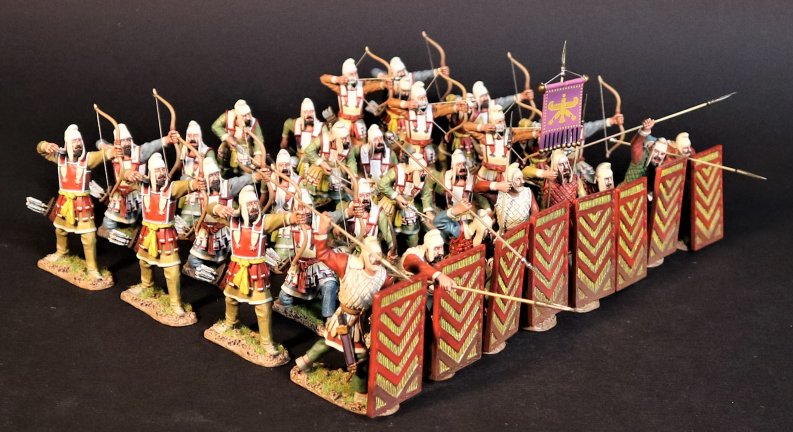
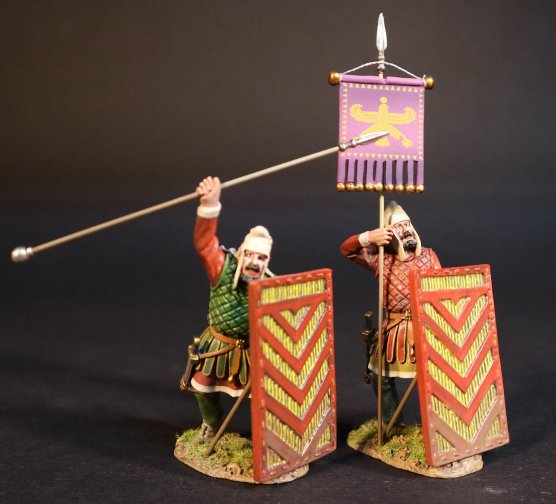
AP-01A
ARMIES AND ENEMIES OF ANCIENT GREECE
AND MACEDONIA,
THE ACHAEMENID PERSIAN EMPIRE,
PERSIAN SPARABARA STANDARD BEARER AND OFFICER
(3 pcs)
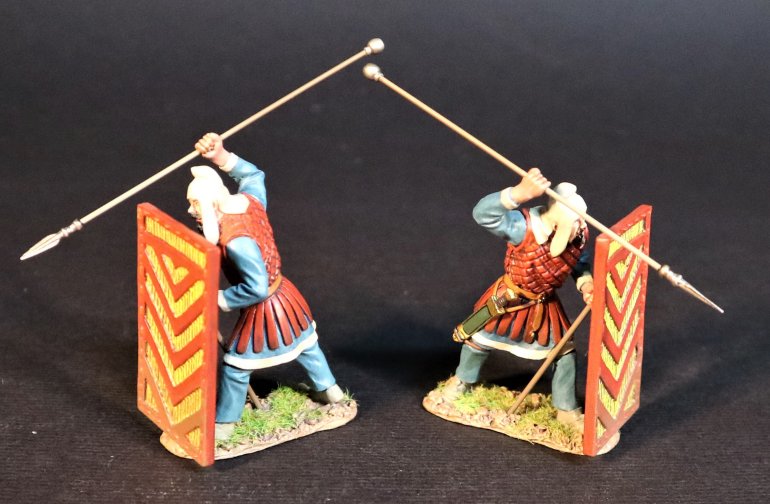
AP-02A
ARMIES AND ENEMIES OF ANCIENT GREECE
AND MACEDONIA,
THE ACHAEMENID PERSIAN EMPIRE,
PERSIAN SPARABARA SPEARMEN
(2 pcs)
These spearmen were often armoured with a quilted linen cuirass, and carried large rectangular wicker shields as a form of light manoeuvrable defence.
This however may have left them at a disadvantage against often heavier armoured opponents such as the hoplite, and the two metre long spear was not able to give the sparabara ample range to engage a trained phalanx with their longer 1.8-2.7 m dory.
The wicker shields may have also been not as effective as thicker wooden shields in prolonged melee combat. The Sparabara could deal with most other infantry, including trained units from the territories around the Persian empire.
The sparabara were supposed to be used in conjunction with Persian cavalry and chariots, which would attack from the flanks and rear.
The Battle of Marathon was an example where the cavalry failed to be deployed, which had catastrophic results.
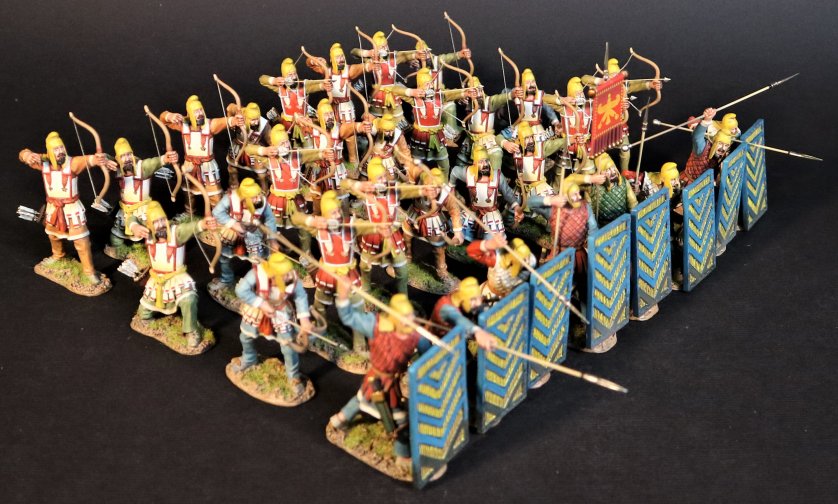
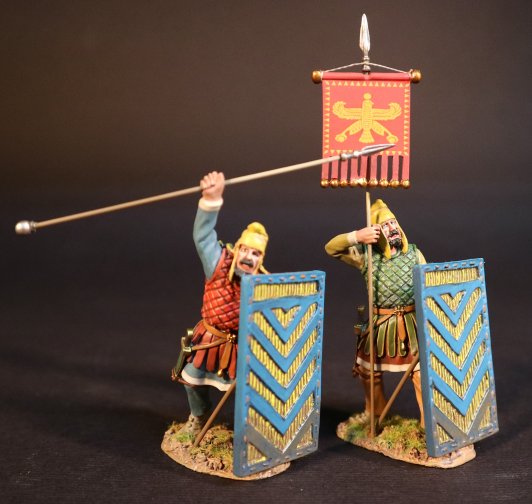
AP-01B
ARMIES AND ENEMIES OF ANCIENT GREECE
AND MACEDONIA,
THE ACHAEMENID PERSIAN EMPIRE,
PERSIAN SPARABARA STANDARD BEARER AND OFFICER
(3 pcs)
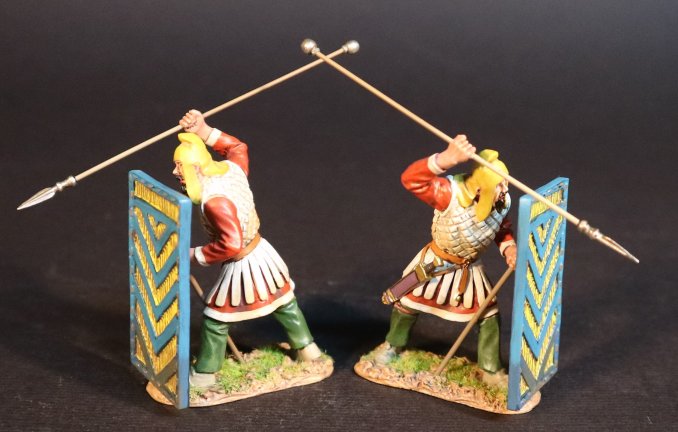
AP-02B
ARMIES AND ENEMIES OF ANCIENT GREECE
AND MACEDONIA,
THE ACHAEMENID PERSIAN EMPIRE,
PERSIAN SPARABARA SPEARMEN
(2 pcs)
**PLEASE CONTACT YOUR DEALER FOR FURTHER INFORMATION**
THE ANCIENTS COLLECTION
ARMIES AND ENEMIES OF GREECE AND MACEDONIA
THE ACHAEMENID PERSIAN EMPIRE 550-330BC
The Achaemenid Empire c. 550–330 BC, also called the First Persian Empire, was an ancient Iranianempire based in Western Asia founded by Cyrus the Great. Ranging at its greatest extent from the Balkans in the west to the Indus Valley in the east, it was larger than any previous empire in history, spanning 5.5 (or 8) million square kilometers. Incorporating various peoples of different origins and faiths, it is notable for its successful model of a centralised, bureaucratic administration (through satraps under the King of Kings), for building infrastructure such as road systems and a postal system, the use of an official language across its territories, and the development of civil services and a large professional army. The empire's successes inspired similar systems in later empires
Achaemenid military units were organized decimally, in tens, hundreds and thousands. This was a simple form of military organization and one quite popular among early armies.
The basic unit of Persian infantry is believed to be of ten men. The first man is a shield-bearer (Spara) with a short spear, and would rest his large whicker shield on the ground to protect the rows of archers behind him.
The Sparabara, meaning “shield bearers” in old Persian, were the front line infantry of the Achaemenid Persian Empire. They were usually the first to engage in hand to hand combat with the enemy. Although not much is known about them today, it is believed that they were the backbone of the Persian army who formed a shield wall and used their two metre long spears to protect more vulnerable troops such as archers from the enemy. The term is also used to refer to the combination of these shield bearers and the archers that were protected by them
The use of shielded spearmen protecting ranks of archers was nothing new, and such units had been the mainstay of Assyrian and Babylonian armies for centuries. The Persian formation was a modification of this arrangement; nine rows of archers would be protected by one row of shield-bearers.


AP-01A
ARMIES AND ENEMIES OF ANCIENT GREECE
AND MACEDONIA,
THE ACHAEMENID PERSIAN EMPIRE,
PERSIAN SPARABARA STANDARD BEARER AND OFFICER
(3 pcs)

AP-02A
ARMIES AND ENEMIES OF ANCIENT GREECE
AND MACEDONIA,
THE ACHAEMENID PERSIAN EMPIRE,
PERSIAN SPARABARA SPEARMEN
(2 pcs)
These spearmen were often armoured with a quilted linen cuirass, and carried large rectangular wicker shields as a form of light manoeuvrable defence.
This however may have left them at a disadvantage against often heavier armoured opponents such as the hoplite, and the two metre long spear was not able to give the sparabara ample range to engage a trained phalanx with their longer 1.8-2.7 m dory.
The wicker shields may have also been not as effective as thicker wooden shields in prolonged melee combat. The Sparabara could deal with most other infantry, including trained units from the territories around the Persian empire.
The sparabara were supposed to be used in conjunction with Persian cavalry and chariots, which would attack from the flanks and rear.
The Battle of Marathon was an example where the cavalry failed to be deployed, which had catastrophic results.


AP-01B
ARMIES AND ENEMIES OF ANCIENT GREECE
AND MACEDONIA,
THE ACHAEMENID PERSIAN EMPIRE,
PERSIAN SPARABARA STANDARD BEARER AND OFFICER
(3 pcs)

AP-02B
ARMIES AND ENEMIES OF ANCIENT GREECE
AND MACEDONIA,
THE ACHAEMENID PERSIAN EMPIRE,
PERSIAN SPARABARA SPEARMEN
(2 pcs)
**PLEASE CONTACT YOUR DEALER FOR FURTHER INFORMATION**

